Fishing Weights and Bobbers
Learn about the different types of fishing weights, bobbers, sinkers and swivels, and how to use them properly for a successful catch.
Fishing Weights and Sinkers
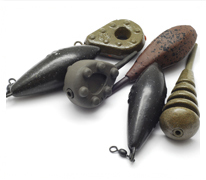 When learning how to fish, you’ll quickly realize that weights and sinkers are essential pieces of fishing gear. What distinguishes fishing weights and bobbers is that weights are designed to drop your lure to where the fish are while bobbers are intended to hold your hook at a desired depth.
When learning how to fish, you’ll quickly realize that weights and sinkers are essential pieces of fishing gear. What distinguishes fishing weights and bobbers is that weights are designed to drop your lure to where the fish are while bobbers are intended to hold your hook at a desired depth.
Weights and sinkers are usually made of lead and can be as small as a BB or as heavy as a few ounces. The tiny BB-shaped ones are called split-shot. They have a groove in the middle that you can slide your line into and then pinch the weight shut. The soft lead will deform in your fingers or you can use your fishing pliers to really crimp it down. Oftentimes, just a single split shot will provide all the weight you need to get a bait to the bottom.
Other types of sinkers include cones for rigging with a worm hook Carolina style, inline or egg sinkers, which you can thread your line though to make bottom rigs, or heavier pyramid sinkers that are used in surf fishing.
Some anglers now use tungsten fishing weights instead of lead. The material is nice and dense like lead and virtually indestructible, but more expensive. No matter what kind you choose, you’ll want to master how to put a hook and sinker on a fishing line.
Bobbers and Floats
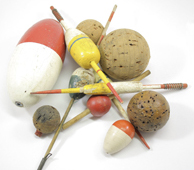 Fishing bobbers attach to your line and keep it on the surface until a fish strikes. The main difference between using fishing weights and bobbers is that bobbers keep the bait suspended. You can set the depth of your baited hook by attaching the bobber a set distance apart.
Fishing bobbers attach to your line and keep it on the surface until a fish strikes. The main difference between using fishing weights and bobbers is that bobbers keep the bait suspended. You can set the depth of your baited hook by attaching the bobber a set distance apart.
Various types of bobbers are available. Floats are more streamlined fishing bobbers and tend to be more sensitive. A specialized bobber called a popping cork is a bobber on a short piece of wire between two beads. When the angler pulls back sharply, the cork pops on the surface, making a sound similar to baitfish feeding, which attracts the redfish and trout. Slip bobbers slide up and down your line. Since this type of bobber is versatile and good for a lot of situations, you’ll want to learn how to attach a slip bobber properly.
Snaps and Swivels
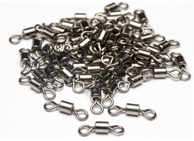 Snaps and swivels can be used when fishing with bobbers and sinkers. Swivels are used to join two parts of your line so that the far end can spin freely, keeping it from twisting and causing problems on the spool. Snaps are swivels with a closure on one end that locks securely. If you tie a snap to the end of your main line, you can quickly attach hooks that have been snelled to a leader with a loop at the end. Or if you tie a swivel or three-way swivel to the end of your line, you can quickly attach leaders with a snap at the end for trolling lures or baits. Some lures dance and spin so much that they call for swivels in order to move freely.
Snaps and swivels can be used when fishing with bobbers and sinkers. Swivels are used to join two parts of your line so that the far end can spin freely, keeping it from twisting and causing problems on the spool. Snaps are swivels with a closure on one end that locks securely. If you tie a snap to the end of your main line, you can quickly attach hooks that have been snelled to a leader with a loop at the end. Or if you tie a swivel or three-way swivel to the end of your line, you can quickly attach leaders with a snap at the end for trolling lures or baits. Some lures dance and spin so much that they call for swivels in order to move freely.
Terminal Tackle
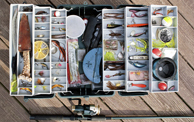 Terminal tackle is a catch-all term for everything you might tie to your fishing line that isn’t a hook or lure, including fishing weights and bobbers, snaps and swivels. Since the right combination of items like bobbers and sinkers can be the key to a successful day on the water, be sure to stock up.
Terminal tackle is a catch-all term for everything you might tie to your fishing line that isn’t a hook or lure, including fishing weights and bobbers, snaps and swivels. Since the right combination of items like bobbers and sinkers can be the key to a successful day on the water, be sure to stock up.
And now that you’ve got all this tackle, it’s time for a tackle box. Go to the Tackle Box Section for more information.
KEEP LEARNING

First Catch Center Trailer Gallery
FCC Trailer Photo Gallery
LEARN MORE

How to Tie a Duncan Knot
Learn to tie a Duncan knot by following these five simple steps. Watch our new video.
LEARN MORE
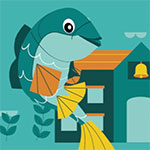
Welcome to Angler Academy!
No one said you can’t bring fishing inside! There’s lots of fun activities we can do right from home
LEARN MORE


.png?lang=en-US&ext=.png)